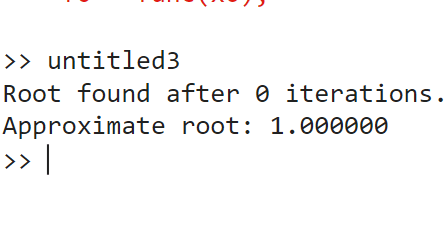Matlab SecantIntroductionThe Secant Method is a numerical technique used for finding roots of a real-valued function. It is an iterative method that approximates the root of a function by drawing a secant line between two points on the function curve and finding where this secant line intersects the x-axis. This method is particularly useful when the derivative of the function is not readily available or difficult to compute. Theory Behind the Secant Method:The secant method is a numerical root-finding algorithm used to approximate the roots of a given function. It is based on the same principle as Newton's method, which involves iteratively refining a guess until a sufficiently accurate approximation to the root is obtained. However, unlike Newton's method, the secant method does not require the evaluation of the function's derivatives. Basic Principle:The key idea behind the secant method is to approximate the derivative of the function using finite differences. Instead of computing the derivative analytically, the secant method approximates the slope of the function between two points by constructing a secant line. This secant line intersects the x-axis at an approximation to the root of the function. Algorithm:Initialization: The secant method begins with two initial guesses, 0x0 and 1x1, which ideally bracket the root of the function. Iteration: At each iteration, the secant method computes a new approximation 2x2 by linearly interpolating between the function values at 0x0 and 1x1. This is done using the secant formula: Termination: Repeat steps 2 and 3 until the desired level of accuracy is achieved or until a maximum number of iterations is reached. Convergence:The secant method typically converges to a root of the function if the initial guesses are sufficiently close to the true root and if the function is well-behaved (continuous and differentiable) in the vicinity of the root. The convergence rate of the secant method is superlinear, meaning that the number of accurate digits approximately doubles with each iteration when the method is close to convergence. Algorithm Overview:The basic idea behind the second method is to iteratively generate approximations to the root of a function by linearly interpolating between two points on the curve until a desired level of accuracy is achieved. The algorithm can be summarized as follows:
ImplementationYou can save this function in a file named secantMethod.m. Now, let's provide an example of how to use this function to find the root of a specific function: Output: 
Explanation: Function Definition:
Input Arguments: The function takes five input arguments:
Initialization:
Iterative Process:
Convergence Check:
Example Usage:
Advantages:No Derivative Required: Unlike some other root-finding methods, such as Newton's method, the secant method does not require evaluating the function's derivatives. This makes it applicable to a wider range of functions, especially when computing derivatives analytically is not feasible or computationally expensive. Simplicity: The secant method is conceptually simple and easy to implement. It involves straightforward iterative calculations without the need for complex mathematical operations. Convergence: The secant method typically converges to a root of the function if the initial guesses are sufficiently close to the true root and if the function is well-behaved (continuous and differentiable) in the vicinity of the root. When conditions are met, the method can converge rapidly, especially if the function is smooth and exhibits moderate curvature around the root. Robustness: The secant method is generally robust and stable, making it suitable for a wide range of problems. It can handle functions with multiple roots as long as appropriate initial guesses are provided. Limitations:Convergence Rate: While the secant method converges rapidly under favorable conditions, its convergence rate is generally slower compared to methods like Newton's method, especially when the initial guesses are far from the root or when the function has sharp turns or irregular behavior near the root. In such cases, the method may require a larger number of iterations to achieve convergence. Initial Guess Dependency: The effectiveness of the secant method heavily depends on the quality of the initial guesses for the root. If the initial guesses are too far apart or do not bracket the root, the method may fail to converge or converge to an incorrect root. Finding suitable initial guesses can sometimes be challenging, especially for functions with multiple roots or complex behavior. No Guarantees of Convergence: While the secant method typically converges under suitable conditions, there is no guarantee of convergence for all functions or initial guesses. In some cases, the method may fail to converge or exhibit erratic behavior, especially if the function has discontinuities, singularities, or other pathological features near the root. Bracketing Requirement: The secant method requires initial guesses that bracket the root, meaning that the function values at the initial guesses must have opposite signs. Finding such initial guesses may take time and effort, especially for functions with complex behavior.
Understanding these advantages and limitations is crucial for effectively applying the method to various problems and interpreting its results.
Next TopicMatlab ColorMap
|
 For Videos Join Our Youtube Channel: Join Now
For Videos Join Our Youtube Channel: Join Now
Feedback
- Send your Feedback to [email protected]
Help Others, Please Share









